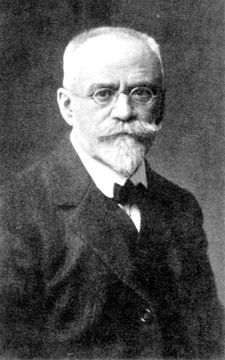Joseph Deniker

Joseph Deniker (
race
in Europe.
Life
Deniker was born in 1852 to French parents in
Natural History Museum
in Paris.
Deniker became one of the chief editors of the Dictionnaire de geographie universelle, and published many papers in the anthropological and zoological journals of France. In 1904 he was invited by the Royal Anthropological Institute of Great Britain to give the Huxley Memorial Lecture. He died in Paris in 1918.
Deniker's classification system
Turco-Mongols
(east and south-east)Deniker's complicated maps of European
races, of which he sometimes counted upwards of twenty, were widely referenced in his day, if only to illustrate the extremes of arbitrary racial classification.[1]
Deniker had an extensive debate with another racial cartographer, peoples of Europe
were composed of three main racial stocks, while Deniker held there were six primary European races (besides four secondary or subsidiary races). The six primary races are:
- Nordic, in the Germanic core territory in Scandinavia, Northern Germany and Frisia, the British Isles and the Baltic
- Littoral or Atlanto-Mediterranean, in the Pyrenees and parts of Spain, western and southern France and north-western Italy
- Oriental; also called Eastern, in the Slavic core territory (Belarus, Ukraine and eastern Poland)
- Adriatic or Dinaric, around the Adriatic Sea, with widespread remnants in parts of France, Austria, Ukraine and Ciscaucasia
- Ibero-Insular in the Iberian Peninsula, western France, southern Italy and the Mediterranean islands
- Occidental (also called Cevenole); corresponding to Ripley's Alpine race,[2][3] was supposedly the race of the paleolithic inhabitants of Europe, with scattered remnants throughout the continent
The four subtypes are:
- Sub-Nordic, on the fringes of Germanic settlement in southern Britain, Germany and the Baltic
- North-Occidental, in the contact zone of Celtic and Germanic, in the British Isles and northern France
- Vistulian, named for the Vistula, in the Germanic-Slavic contact zone in Poland
- Sub-Adriatic; in the Continental Celticcore territory
According to
Nordic theory
to the engine of civilization. Grant adopted Ripley's three-race model for Europeans, but disliked Ripley's use of the "Teuton" for one of the races. Grant transliterated la race nordique into "Nordic", and promoted it to the top of his racial hierarchy in his own popular racial theory of the 1910s and 1920s.
Deniker proposed that the concept of race was too confusing, and instead proposed the use of the word "
Alfred C. Haddon
. Ripley argued that Deniker's idea of a race should be rather called a "type", since it was far less biologically rigid than most approaches to the question of race.
Selected works
- Recherches anatomiques et embryologiques sur les singes anthropoides (1886)
- Etude sur les Kalmouks (1883)
- Les Ghiliaks (1883)
- Races et peuples de la terre (1900)
- The races of man: an outline of anthropology and ethnography (1900)
The author abbreviation Deniker is used to indicate this individual as the author when citing a botanical name.[5]
References
- JSTOR 2842946. Retrieved 2016-01-22.
- JSTOR 2843096.
- JSTOR 2842946.
- ^ Czekanowski, Jan (1934). Człowiek w Czasie i Przestrzeni (eng. A Human in Time and Space) - The lexicon of biological anthropology. Kraków, Poland: Trzaska, Ewert i Michalski - Bibljoteka Wiedzy.
- ^ http://www.genres.de/CF/ipgri_cwr/demo/authors.cfm?searchVal=Deniker[permanent dead link]
- Arthur Keith and Alfred C. Haddon, "Obituary: Dr. Joseph Deniker", Man 18 (May 1918): 65–67.
- Ashley Montagu, "The Concept of Race", American Anthropologist 64:5 (October 1962): 919–928.
